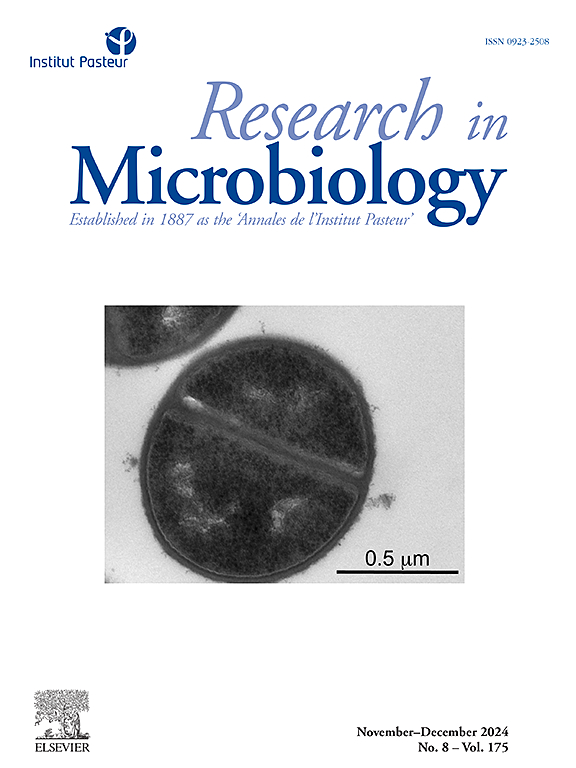Metabolic adaptation via glycolysis and iron acquisition drives Klebsiella pneumoniae–induced intraocular inflammation and visual impairment
IF 3.4
4区 生物学
Q3 MICROBIOLOGY
引用次数: 0
Abstract
Klebsiella pneumoniae is a major cause of endogenous endophthalmitis, a rapidly progressing intraocular infection associated with severe inflammation and vision loss. The vitreous body presents a hypoxic and iron-restricted environment, yet the bacterial metabolic adaptations that enable persistence in this niche remain largely unknown. Here, we show that K. pneumoniae undergoes metabolic reprogramming to facilitate intraocular survival, characterized by enhanced glycolysis and siderophore-mediated iron acquisition. Proteomic profiling under vitreous-mimicking conditions revealed significant upregulation of PfkA, PykF, and EntB. Targeted deletion of these genes impaired bacterial growth under hypoxia and iron limitation, and significantly reduced intraocular colonization, proinflammatory cytokine production, and visual impairment in a murine model. Double mutants lacking both glycolytic and iron acquisition pathways were nearly avirulent. Correspondingly, infected eyes exhibited lower levels of lactate and iron, reflecting reduced bacterial metabolic activity. These findings establish glycolysis and iron acquisition as critical determinants of K. pneumoniae virulence in the eye and provide insight into the metabolic strategies underpinning bacterial persistence in nutrient-limited host environments.
通过糖酵解和铁获取的代谢适应驱动肺炎克雷伯菌引起的眼内炎症和视力损害。
肺炎克雷伯菌是内源性眼内炎的主要病因,眼内炎是一种进展迅速的眼内感染,伴有严重炎症和视力丧失。玻璃体呈现出缺氧和限制铁的环境,然而细菌的代谢适应使其能够在这个生态位中持续存在,这在很大程度上仍然是未知的。在这里,我们发现肺炎克雷伯菌经历代谢重编程以促进眼内生存,其特征是糖酵解和铁载体介导的铁获取增强。在玻璃体模拟条件下的蛋白质组学分析显示PfkA、PykF和EntB的显著上调。在小鼠模型中,这些基因的靶向缺失会在缺氧和铁限制下损害细菌的生长,并显著减少眼内定植、促炎细胞因子的产生和视力损害。缺乏糖酵解和铁获取途径的双突变体几乎是无毒的。相应地,受感染的眼睛显示出较低的乳酸和铁水平,反映了细菌代谢活动的减少。这些发现确定了糖酵解和铁获取是肺炎克雷伯菌眼部毒力的关键决定因素,并为在营养有限的宿主环境中支持细菌持久性的代谢策略提供了见解。
本文章由计算机程序翻译,如有差异,请以英文原文为准。
求助全文
约1分钟内获得全文
求助全文
来源期刊

Research in microbiology
生物-微生物学
CiteScore
4.10
自引率
3.80%
发文量
54
审稿时长
16 days
期刊介绍:
Research in Microbiology is the direct descendant of the original Pasteur periodical entitled Annales de l''Institut Pasteur, created in 1887 by Emile Duclaux under the patronage of Louis Pasteur. The Editorial Committee included Chamberland, Grancher, Nocard, Roux and Straus, and the first issue began with Louis Pasteur''s "Lettre sur la Rage" which clearly defines the spirit of the journal:"You have informed me, my dear Duclaux, that you intend to start a monthly collection of articles entitled "Annales de l''Institut Pasteur". You will be rendering a service that will be appreciated by the ever increasing number of young scientists who are attracted to microbiological studies. In your Annales, our laboratory research will of course occupy a central position, but the work from outside groups that you intend to publish will be a source of competitive stimulation for all of us."That first volume included 53 articles as well as critical reviews and book reviews. From that time on, the Annales appeared regularly every month, without interruption, even during the two world wars. Although the journal has undergone many changes over the past 100 years (in the title, the format, the language) reflecting the evolution in scientific publishing, it has consistently maintained the Pasteur tradition by publishing original reports on all aspects of microbiology.
 求助内容:
求助内容: 应助结果提醒方式:
应助结果提醒方式:


